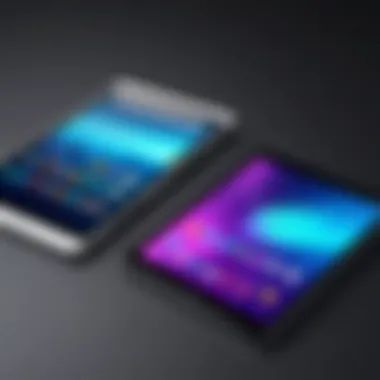Best Budget Tablets: In-Depth Analysis and Picks


Intro
Navigating the realm of tablets, especially budget options, can be quite daunting for anyone, particularly for IT professionals and tech enthusiasts. The market is saturated with various models, each promising value and performance. Understanding what to look for in a budget tablet is essential. This article meticulously analyzes several models, focusing on their hardware specifications, performance metrics, software features, and overall user experience. This exploration aims to equip readers with the knowledge needed to make informed decisions when investing in a budget tablet.
Hardware Overview
Specifications
When considering a budget tablet, the specifications play a crucial role in determining the device’s capability. Key components include the processor, RAM, display quality, and battery life. For example, a model like the Amazon Fire HD 10 comes with an octa-core processor and 3GB of RAM, which is quite reasonable for everyday tasks such as browsing and streaming. The Lenovo Tab M10 Plus also features impressive specifications, making it suitable for both entertainment and productivity.
- Processor: Essential for multitasking and app performance.
- RAM: More RAM typically means better performance when running multiple apps.
- Display: Consider resolution and screen technology for better viewing experiences.
- Battery Life: Longer battery life is crucial for portability and convenience.
Performance Metrics
Analyzing performance involves looking into both synthetic benchmarks and real-world usage scenarios. Tablets like the Samsung Galaxy Tab A7 have shown to perform well under typical usage conditions. They can handle streaming, light gaming, and productivity tasks without lag. Performance metrics such as Geekbench scores or 3DMark scores offer insights but should be complemented by user reviews and testing in daily routines.
"Performance in real-world usage often differs from synthetic benchmarks, so user experiences provide valuable insights."
Software Analysis
Features and Functionality
Software is as vital as hardware in budget tablets. Operating systems and included software can significantly impact usability. Most budget tablets operate on Android, with some, like the Apple iPad (9th generation), providing a bespoke operating system for optimized performance. Features such as split-screen functionality and app availability are important considerations.
- Operating System: Choose between Android and iOS based on familiarity and app ecosystems.
- Built-in Apps: Availability of useful pre-installed applications can enhance functionality.
- Customization: Greater customization options in Android can be appealing to tech enthusiasts.
User Interface and Experience
User interface impacts user experience greatly. A cluttered UI can make navigation challenging. Tablets like the Microsoft Surface Go 2 excel in this area, offering a straightforward interface that does not overwhelm users. Consider how intuitive the device is, and whether it aligns with your intended usage, whether for professional or casual tasks.
The overall usability, responsiveness, and ergonomics of the tablet can enhance user satisfaction. It is advisable to test models in-store whenever possible.
Foreword to Budget Tablets
As technology becomes an essential part of daily life, the need for accessible devices grows. Budget tablets have emerged as a popular choice for many consumers seeking adequate performance without excessive spending. This article aims to offer a comprehensive look into the world of budget tablets, focusing on their selection amidst various factors like price, specifications, and intended use cases.
Understanding the Budget Tablet Market
The budget tablet market is characterized by its diversity. Numerous brands compete, each offering different models to cater to a wide range of users. This segment appeals to students, casual users, and even professionals looking for a secondary device.
Key players include manufacturers like Amazon with its Fire series, Lenovo's Tab series, and Samsung's Galaxy Tab A. These tablets vary in capabilities, showcasing what budget technology can provide.
While these devices generally come with lower processing power and feature sets compared to premium models, they should not be dismissed outright. Buyers must identify their needs and match them to features that budget tablets offer.
Importance of Value in Budget Devices
In a saturated market, value becomes a critical aspect for potential buyers. Customers must evaluate not only the upfront cost but also the quality and longevity of the device. A lower price point should not come at the expense of functionality and durability. When investing in a budget tablet, consumers should consider:
- Longevity: Will the device last for a reasonable time?
- Utility: Does it meet the required needs for tasks, whether for work, school, or entertainment?
- Support: Are updates and assistance provided to maintain its functionality over time?
Ultimately, the importance of value is about striking a balance. Purchasers should gain adequate features for their investment, ensuring their choice serves them well without unwanted surprises over time.
"Choosing a budget tablet does not mean sacrificing quality. It signifies a thoughtful approach to resource allocation while achieving practical technology use."
Key Factors to Consider
When shopping for a budget tablet, it’s essential to understand the various key factors that influence performance and usability. In this section, we examine critical elements that help in selecting the right budget tablet, aiming to ensure users make informed decisions.
Performance Metrics
Processor Speed
The processor speed is crucial in determining how a tablet performs during various tasks. A faster processor can handle applications smoothly and multitask more efficiently. Common choices in budget tablets include quad-core processors, which provide a balance between price and performance.
For instance, an efficient processor ensures a jolt-free experience while web browsing or running multiple apps. However, there can be a trade-off, as the higher the speed, the higher the price may be. Budget buyers often find models with adequate processor speeds around 1.5 GHz to 2.0 GHz to be satisfactory.
RAM Capacity


RAM capacity directly influences a tablet's ability to handle multiple tasks simultaneously. Generally, more RAM allows a device to run more applications without slowdowns. For budget tablets, 2GB to 4GB of RAM is typically standard.
While less RAM might suffice for basic tasks such as reading and browsing, limitations may arise during more intensive use. Therefore, understanding RAM requirements for intended use is significant.
Storage Options
Storage options are important as they determine how much data you can keep on your device. Most budget tablets will come with internal storage ranging from 16 GB to 64 GB. While this may seem sufficient, users should consider future storage needs, as applications can consume substantial space. Many tablets support expandable storage via microSD cards, which is a beneficial feature for budget tablets. This expands usability and increases convenience.
Operating System
Android
Android is a popular choice in the budget tablet market, offering versatility in apps and customizability. Tablets running Android typically come at lower price points while still providing extensive app compatibility.
The main advantage is the vast ecosystem of applications available on the Google Play Store. However, the user experience may vary due to different manufacturers’ software skins. A less streamlined interface can sometimes hinder ease of use.
iOS
While iOS devices tend to be more expensive, there are some budget-friendly options available, like the iPad Mini. iOS brings in a polished user experience, with seamless app integration and regular updates.
One unique feature of iOS is its ability to maintain performance over years through updates. Nevertheless, the high entry price for budget-focused users can be a drawback compared to Android devices.
Windows
Windows tablets offer familiar functionalities and can handle desktop applications, appealing to those who require a traditional computing experience. This is especially beneficial for productivity tasks.
Budget Windows tablets vary significantly in specifications, sometimes presenting users with challenges regarding performance consistency. Software compatibility can be an advantage, but users need to be cautious about specifications to ensure adequate performance.
Display Quality
Resolution
Resolution impacts visual clarity when using a tablet. Typically, HD (1280x800) is the minimum acceptable standard for budget tablets, with higher resolutions like Full HD (1920x1080) offering better clarity for media consumption.
Higher resolution screens tend to enhance the user experience but also increase costs. Be mindful of this when considering specific use cases.
Screen Size
Screen size plays a significant role in user experience. Most budget tablets range from 7 to 10 inches. Larger screens offer better usability for media consumption and productivity, but they can be less portable. Users should select a size based on their primary use.
Touch Sensitivity
Touch sensitivity determines how responsive a tablet is to user inputs. A tablet with high touch sensitivity provides a more engaging user experience, essential for tasks such as drawing or gaming. However, many budget options may exhibit delayed responses, which can frustrate the user. Selecting a model noted for its responsiveness can reduce such issues.
Battery Life
Average Longevity
Average longevity is an essential factor as it determines how long the tablet will run without needing a charge. Budget tablets often provide between 6 to 10 hours of usage. For users who plan longer sessions, higher longevity is advantageous.
Battery longevity is essential for portability, especially for those who travel frequently.
Charging Time
The charging time of a tablet affects usability in real-time. Faster charging capabilities can offer convenience, allowing users to charge up quickly in a pinch. Models with fast charging features can significantly reduce downtime, which is particularly important for users who are constantly on-the-go.
Build Quality and Design
Material Used
The material used in the construction of a tablet affects its overall durability and feel. Common materials include plastic and aluminum. Tablets made from aluminum are often more durable, offering a premium feel. In contrast, plastic is lightweight but may be less durable. Understanding material differences helps ensure you choose a tablet that stays intact under regular usage.
Durability
Durability assesses how well the tablet can resist daily wear and tear. A more rugged design is often favorable for users with active lifestyles. Budget tablets can vary widely in this regard, so research user feedback on durability can provide insights.
Weight
Weight matters for portability. Light tablets are more comfortable for extended usage or travel. Users should evaluate how much weight is manageable for their daily activities. Most budget-friendly options aim for a balance between size and usability while keeping weight in mind.


Popular Budget Tablets Evaluated
Evaluating popular budget tablets is crucial for understanding the landscape of affordable devices. This section reviews various models based on concrete specifications, performance metrics, and user experiences. By delving into individual tablets, readers can better appreciate the diversity of options in the budget segment, which helps them identify the right product tailored to their needs. Such analysis clarifies the strengths and limitations of each model, providing insightful comparisons that assist in making informed purchasing decisions.
Tablet A
Specifications
Tablet A instills confidence through its specifications, which include a competitive processor and reasonable RAM. The processing speed ensures that applications launch promptly, which is fundamental for daily tasks. Its standout characteristic is a vibrant display, great for media consumption and web browsing. However, the storage options can be limited, restricting users who require significant space for files or applications. Despite this, its lightweight design makes it a popular choice among users seeking portability.
Performance Analysis
The performance of Tablet A is particularly noteworthy. Benchmarks indicate that it handles multitasking with ease, allowing users to switch between applications without noticeable lag. The unique feature here is its optimized software, which enhances usability. Despite its potent performance, heavier applications can strain the device, leading to occasional slowdowns. Overall, it succeeds as a versatile tablet for general use while offering decent gaming capabilities.
User Feedback
User feedback for Tablet A tends to highlight its robust battery life, often lasting through extended use. Many users appreciate its responsiveness and ease of navigation. Nevertheless, some reviews express concern regarding the device's build quality, citing that it feels somewhat flimsy. Thus, while it excels in performance and usability, potential buyers should be mindful of its physical durability.
Tablet B
Specifications
Tablet B presents a competitive edge with impressive specifications that include a high-resolution screen and adequate processing power. This model boasts a larger display, making it a favorable option for media enthusiasts. The unique feature of its specifications is the inclusion of expandable storage, which allows users to enhance capacity as needed. This aspect significantly increases its appeal for users who manage extensive data.
Performance Analysis
In terms of performance, Tablet B has gained attention for its reliable user experience with many everyday apps. It demonstrates solid performance in terms of speed and smoothness. Users find it well-suited for casual gaming, although complex titles can push it to its limits. Additionally, its thermal management is commendable, preventing overheating during prolonged use, although some users report a slight decrease in battery efficiency under load.
User Feedback
The general feedback surrounding Tablet B is predominantly positive. Users emphasize its bright display and robust sound quality, especially for video streaming. However, some have reported software bugs following updates. Balancing performance and user complaints, it's generally considered a reliable device for multimedia use, albeit with some suggestions for caution regarding updates.
Tablet
Specifications
Specifications for Tablet C focus on delivering essential features at a lower price point. It sports a moderate resolution, which suits casual users but might disappoint those seeking top-tier visuals. One of its key characteristics is its excellent connectivity options, including Bluetooth and Wi-Fi, ensuring users stay connected. However, its lack of premium features could deter users accustomed to higher-end models.
Performance Analysis
Performance-wise, Tablet C offers an efficient experience for basic tasks like browsing and document editing. Its performance analysis reveals consistent speed, but multitasking can exhibit some limitations. Unique to this device is its extremely responsive touchscreen, which many users find satisfying. Although, it struggles with demanding applications, marking it less suitable for gamers or heavy application users.
User Feedback
Tablet C tends to garner mixed user feedback. Some appreciate its affordability and essential functionality, but others express dissatisfaction regarding the display's brightness and color accuracy. Its limitations are acknowledged, yet many find it an acceptable option for simple tasks. Users often commend its quick setup process, indicating it is user-friendly for those less tech-savvy.
Tablet
Specifications
Tablet D emerges as a frontrunner with specifications that target tech-savvy users looking for value. A standout characteristic is the integration of high-spec camera functionality, appealing to those who prioritize photography. Its storage capacity is notably generous, accommodating various apps and files. However, its build quality faces scrutiny, as some users report concerns about durability under daily use.
Performance Analysis
The performance metrics of Tablet D show adeptness with complex applications, providing a smooth experience for users engaged in creative tasks. It features a unique processing chip that enhances graphics rendering, which gamers will find advantageous. However, this comes at the cost of battery efficiency, as extensive gaming can lead to quicker battery drain. Overall, it presents great potential for power users despite certain trade-offs.
User Feedback
User feedback indicates that while Tablet D excels in performance, it falls short in terms of longevity. Many praise its visual capabilities and processing speed, though heavy users recommend caution due to battery life. The general consensus highlights it as a reliable option for serious tasks, albeit with specific caveats regarding its durability and charging requirements.
Use Cases for Budget Tablets
Understanding the use cases for budget tablets is crucial in selecting the right device that fits one's needs. Each potential user has distinct requirements and expectations from a tablet. Whether it's for work, entertainment, gaming, or education, budget tablets can serve various functions effectively. However, it is important to identify how these devices will be used to ensure the best value for investment.
General Productivity Tasks
Budget tablets can be quite effective for general productivity tasks. They can handle email, document editing, and basic spreadsheet management. Many models support productivity apps like Microsoft Office or Google Workspace.
For professionals, having a lightweight device can make it easier to work on the go. These tablets are often equipped with decent processors and adequate RAM, allowing for a smooth user experience during multitasking. Battery life plays significant role here, as longer usage without charging is vital for productivity.


Media Consumption
Media consumption is one of the primary uses for budget tablets. These devices can effectively stream videos, play music, and display e-books. Tablets often come with decent screens that enhance viewing experiences. Furthermore, most budget tablets support popular streaming services like Netflix, Hulu, and YouTube.
For users who want to relax with movies or television shows, a good display quality is key. Many models now offer Full HD resolutions, which provide clear and vibrant visuals. This made them a solid choice for anyone who enjoys binge-watching on a budget.
Casual Gaming
Casual gaming is another area where budget tablets can shine. While they may not handle high-end gaming well, many can support lighter games that require moderate graphics resources. This includes classic games and casual mobile experiences.
Users who play frequently should pay attention to performance metrics, including processor speed and RAM. Tablets with sufficient capacity can provide a satisfactory gaming experience without lag. Affordable tablets from respected brands offer a good balance between cost and gaming capability, ensuring enjoyment without overspending.
Education and E-Learning
Budget tablets are also very useful for educational purposes. With the rise of e-learning, having a tablet that can support various educational applications is essential. This makes them an ideal option for students, particularly at the primary and secondary levels.
Many educational platforms and online courses are optimized for tablet use. Schools and universities increasingly implement digital learning tools that work seamlessly on budget devices. Additionally, the ability to annotate documents and take notes digitally can enhance the learning experience.
Professional Use in IT
In the IT field, budget tablets can help with various tasks, although their use may be more limited compared to higher-end models. For IT professionals, these devices can be used for troubleshooting, testing, and remote access applications. Compatibility with specific applications should be considered to ensure functionality.
While they may not replace a full laptop for every job, budget tablets can serve as supplementary devices. They provide flexibility and convenience for on-site work or when quick access to information is needed. Coupled with adequate security features, they become reliable tools in an IT professional's arsenal.
"Knowing the use cases of a tablet ensures that users invest wisely according to their specific needs."
Budget tablets offer numerous benefits across various use cases. Understanding how these devices align with specific needs can significantly enhance the value users derive from their purchase.
Tips for Maximizing Value
Maximizing value in the budget tablet market is crucial for individuals seeking to make wise investment choices. In this section, we will cover essential strategies that allow buyers to enhance their purchasing power without compromising on quality or performance. The goal is to provide insights that assist in identifying valuable deals, which becomes increasingly relevant in a saturated market where affordable options abound. Buyers equipped with this knowledge can navigate the complexities of the tablet market with greater confidence.
Refurbished and Open Box Options
Purchasing refurbished or open box tablets can lead to significant savings. Many reputable retailers, like Best Buy and Amazon, offer these products at a fraction of the original price. Refurbished tablets are often professionally inspected and repaired, ensuring they meet quality standards. Open box products are usually items returned shortly after purchase, often showing minimal signs of use.
- Cost Savings: Typically, refurbished and open box options are at least 20-30% cheaper than new models.
- Quality Assurance: Many manufacturers provide warranties for refurbished products, adding a layer of protection for the buyer.
- Environmentally Friendly: Buying refurbished contributes to sustainability efforts, reducing electronic waste.
Holiday and Seasonal Sales
Timing a purchase to coincide with holiday and seasonal sales can lead to impressive savings. Major retail events such as Black Friday, Cyber Monday, or Back-to-School sales present excellent opportunities to find budget tablets at discounted prices. During these periods, retailers often offer exclusive deals. Consider the following:
- Research Early: Start monitoring prices weeks in advance to gauge which devices are likely to be on sale.
- Sign Up for Alerts: Many retailers send notifications of upcoming sales through their websites or newsletters. This can be beneficial for snagging great deals as soon as they are available.
- Compare Prices: Utilize price comparison websites or tools to ensure you are getting the best possible deal.
Bundles and Accessories
Purchasing tablets in bundles or with accessories can amplify value. Often, retailers provide special deals where extra items like cases, stylus pens, or screen protectors are included at a reduced total price. This can save money on essential items that customers may otherwise need to buy separately.
- Warranty Opportunities: Some bundles come with extended warranty options, which can offer peace of mind.
- Learning Resources: Certain tablet bundles may include subscriptions to learning platforms or exclusive content, enhancing the overall value of the purchase.
- Analyze Needs: Before making a bundle purchase, assess your specific requirements to ensure the additional products align with usage.
Buyers prepared with these strategies can elevate their experience in the budget tablet market, ensuring they optimize every dollar spent while acquiring a device that meets their specific needs.
The End: Finding the Best Tablet on a Budget
In navigating the budget tablet market, the importance of carefully weighing options cannot be overstated. Budget tablets serve a unique role in technology; they provide crucial functionality at reduced costs, making them accessible to a broader audience. The insights presented in this article are designed to aid various users, from IT professionals to casual users. A well-informed decision leads to maximizing utility and satisfaction from your purchase.
Summarizing Key Considerations
When selecting a budget tablet, there are several factors that deserve attention:
- Performance: Look at the processor speed and RAM. They dictate how smoothly the device runs apps and multitasks.
- Operating System: The choice between Android, iOS, or Windows impacts compatibility and functionality.
- Display Quality: The resolution, size, and touch sensitivity affect user experience dramatically.
- Battery Life: Consider average longevity and charging times as they will determine usability on the go.
- Build Quality: Material and durability are crucial, especially for portable devices.
These elements provide a framework for understanding what each budget tablet has to offer. Consider individual needs carefully. For instance, if heavy media consumption is a priority, prioritize a high-resolution display.
Final Recommendations
Based on evaluations presented earlier, here are some concluding suggestions:
- Opt for the Samsung Galaxy Tab A for a versatile experience with commendable performance and battery life.
- For those favoring educational use, the Fire HD 10 stands out as a cost-effective solution with robust functionality for e-learning.
- If media consumption is crucial, consider the Lenovo Tab P11, which delivers excellent display quality at a reasonable price.
Ultimately, the best tablet for you hinges on your specific requirements and budget constraints. Investing time in assessing these tablets based on the highlighted key factors will lead to a satisfactory purchase that aligns with your technological needs.
"Understanding the nuances of budget tablets enables one to select a device that not only fits the wallet but also fulfills user expectations."
As the tech landscape evolves, so too do options in budget devices. Keeping abreast of performance metrics, user feedback, and manufacturer changes is prudent in navigating future purchases.



